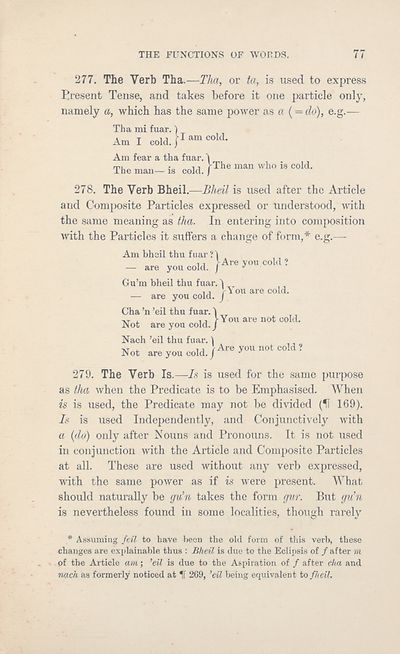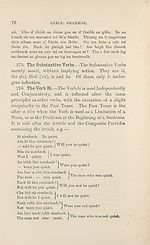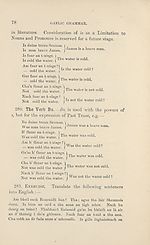Download files
Complete book:
Individual page:
Thumbnail gallery: Grid view | List view

THE FUNCTIONS OF WORDS.
277. The Verb Tha.—Tha, or ta, is used to express
Present Tense, and takes before it one particle only,
namely a, which has the same power as « (= do), e.g.—
Tha mi fuar.
Am I cold.
Am fear a tha fuar.
The man— is cold.
jThe
who is cold.
278. The Verb Bheil.—Bheil is used after the Article
and Composite Particles expressed or understood, with
the same meaning as tha. In entering into composition
with the Particles it suffers a change of form,* e.g.—-
Am bheil thu fuar
— are you cold. /
you cold ?
Gu’m bheil thu fuar.
— are you cold, j 0
Cha ’n ’eil thu fuar. I
Not are you cold./You
re not cold.
Nach ’eil thu fuar. ^
Not are you cold, j
Are you not cold ?
279. The Verb Is.—Is is used for the same purpose
as tha when the Predicate is to be Emphasised. When
is is used, the Predicate may not be divided (II 169).
Is is used Independently, and Conjunctively with
a (do) only after Nouns and Pronouns. It is not used
in conjunction with the Article and Composite Particles
at all. These are used without any verb expressed,
with the same power as if is were present. What
should naturally be gu’n takes the form gur. But gu’n
is nevertheless found in some localities, though rarely
* Assuming feil to have been the old form of this verb, these
changes are explainable thus : Bheil is due to the Eclipsis of / after m
of the Article am; ’eil is due to the Aspiration of / after cha and
nach. as formerly noticed at IT 269, ’eil being equivalent to fhcil.
277. The Verb Tha.—Tha, or ta, is used to express
Present Tense, and takes before it one particle only,
namely a, which has the same power as « (= do), e.g.—
Tha mi fuar.
Am I cold.
Am fear a tha fuar.
The man— is cold.
jThe
who is cold.
278. The Verb Bheil.—Bheil is used after the Article
and Composite Particles expressed or understood, with
the same meaning as tha. In entering into composition
with the Particles it suffers a change of form,* e.g.—-
Am bheil thu fuar
— are you cold. /
you cold ?
Gu’m bheil thu fuar.
— are you cold, j 0
Cha ’n ’eil thu fuar. I
Not are you cold./You
re not cold.
Nach ’eil thu fuar. ^
Not are you cold, j
Are you not cold ?
279. The Verb Is.—Is is used for the same purpose
as tha when the Predicate is to be Emphasised. When
is is used, the Predicate may not be divided (II 169).
Is is used Independently, and Conjunctively with
a (do) only after Nouns and Pronouns. It is not used
in conjunction with the Article and Composite Particles
at all. These are used without any verb expressed,
with the same power as if is were present. What
should naturally be gu’n takes the form gur. But gu’n
is nevertheless found in some localities, though rarely
* Assuming feil to have been the old form of this verb, these
changes are explainable thus : Bheil is due to the Eclipsis of / after m
of the Article am; ’eil is due to the Aspiration of / after cha and
nach. as formerly noticed at IT 269, ’eil being equivalent to fhcil.
Set display mode to:
![]() Universal Viewer |
Universal Viewer | ![]() Mirador |
Large image | Transcription
Mirador |
Large image | Transcription
| An Comunn Gàidhealach > An Comunn Gàidhealach Publications > Scottish Gaelic as a specific subject > (81) |
|---|
| Permanent URL | https://digital.nls.uk/125955989 |
|---|
| Description | This contains items published by An Comunn, which are not specifically Mòd-related. It includes journals, annual reports and corporate documents, policy statements, educational resources and published plays and literature. It is arranged alphabetically by title. |
|---|
| Description | A collection of over 400 items published by An Comunn Gàidhealach, the organisation which promotes Gaelic language and culture and organises the Royal National Mòd. Dating from 1891 up to the present day, the collection includes journals and newspapers, annual reports, educational materials, national Mòd programmes, published Mòd literature and music. |
|---|---|
| Additional NLS resources: |
|

